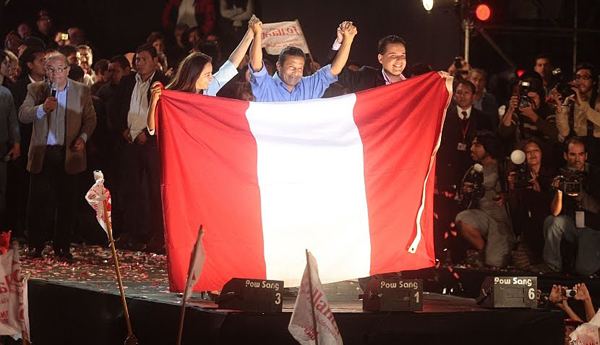
On 5 June 2011, Ollanta Humala became the new president of Peru, winning 51.6% of the second round. He takes office on 28 July and replaces US henchman Alan Garcia. However Humala’s Gana Perú has only 47 of the 130 seats in Congress, so former president Toledo (2001-2006), whose alliance Perú Posible has 21 seats, has taken a share in government with him in order to limit changes that Humala attempts .
This was Humala’s second attempt at the presidency. In 2006 he lost the second round to the corrupt populist Alan Garcia. In 2000, he led a short-lived military rebellion against the now-incarcerated criminal President Alberto Fujimori. This time he campaigned on an anti-corruption platform, working with advisers from Brazil to defeat his reactionary opponents who worked hard to paint him (and his wife) as in the pay of President Chavez of Venezuela. So in May, Toledo told the Washington Post ‘The Brazilians are providing the political ideas, but the money is coming from Chavez’, only to decide opportunistically in July that Humala ‘is nearer to Lula than Chavez’.
In his victory speech, Humala promised that poor Peruvians would share the country’s mineral wealth, rather than see it given away to the mostly foreign-owned mining companies as Garcia had. Garciaspent much of the proceeds of the mining boom on road, ports and other infrastructure projects,accelerating the export of the country’s natural wealth. The environment, the indigenous and rural Peruvians were either ignored or further deprived of their rights. Garcia allowed the free transfer of capital, enforced free competition, guaranteed private property, freedom of remittances, and gave extraction concessions for 60 years. The state’s tax revenues shrank by nearly $2.7 billion in 2006 and 2007 because of the government’s decision not to charge royalties. Large mining companies in Peru took in windfall earnings of nearly $3.45bn in 2006 and close to $4.14bn in 2007, while 25 paid no royalties at all. Garcia opened communal forest lands and water resources to oil drilling, logging, mining and large-scale farming calling it a ‘modern social model’ of free trade and investment to ‘redress social inequalities’.
More than five million people in the arid southern highlands, about 73% of the indigenous Quechua and Aymara communities, live below the poverty line. In most rural subsistence communities, hunger is rampant. Women are worst affected struggling to make it possible for their husbands to migrate to search for temporary work. The high school drop-out rate is more than 50%. Nationally around 25% of children below five suffer from chronic malnutrition, rising to 49% in the remote mountainous region of Huancavelica in the south. Fifty four percent of Peru’s population lives in poverty. The UN estimates that 19% live in absolute poverty, less than $1 a day. The top 10% of the population controls 35.4% of the country’s wealth. The bottom 10% owns just 1.6%. UN figures also state 240 in every 100,000 women die in child birth, one of the highest rates in the Americas. No progress has been made in reducing this in the last decade.
The poorest of the indigenous peasants are in the hands of narco-business: 47% of peasants tend 1 to 3 hectares, of which 60% is given over to coca. For peasants with 4 to 8 hectares this proportion falls to 8%, and for those with over 16 hectares it is 4%. The growth of coca requires deforestation. In Valle del Rio Apurímac y Ene, coca production has doubled in the last nine years. The indiscriminate use of chemicals on the land has reduced fertility dramatically so that the average rice harvest is 800 kilos per hectare compared to 4,100 kilos in the rest of Peru is. The indigenous peoples’ anger found earlier expression in the leadership of Humala’s brother, Antauro. The brothers are branded ‘ultranationalists’ by the racist ruling class, while on 9 June ‘The Economist’ declared Antauro a ‘fascist’.
Humala plans to impose a windfall profits tax of up to 40% on mining companies, in order to build hospitals and schools. One of Humala’s early tasks will be to renegotiate higher royalties on gas exports made by the Camisea natural gas consortium, lead by Argentina’s Pluspetrol which includes Spain’s Repsol, U.S.-based Hunt Oil and South Korea’s SK Energy. Humala’s victory saw a 12.45% fall on the Lima stock exchange in one day. Humala aims to solve Peru’s problems of inequality, illiteracy and malnutrition. He denies this is an ideological programme, but for imperialism and its allies it is and they will fight him all along the line.
By Alvaro Michael




